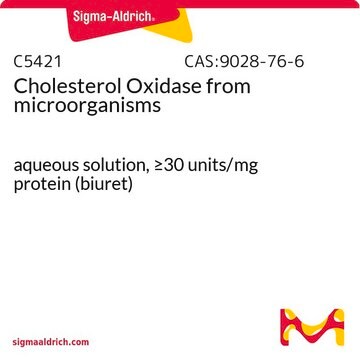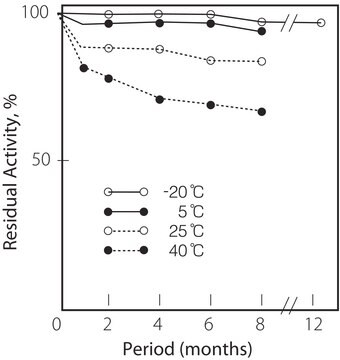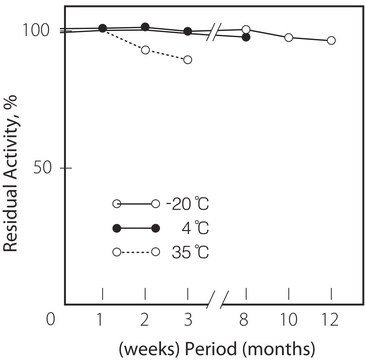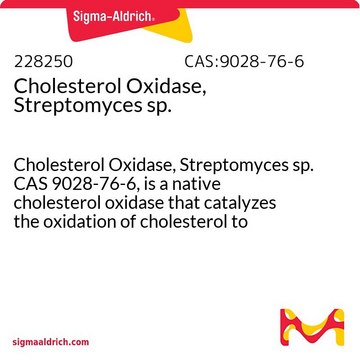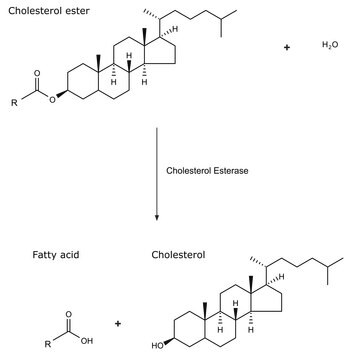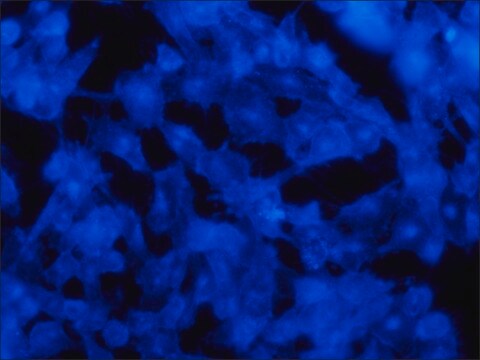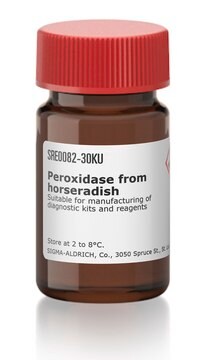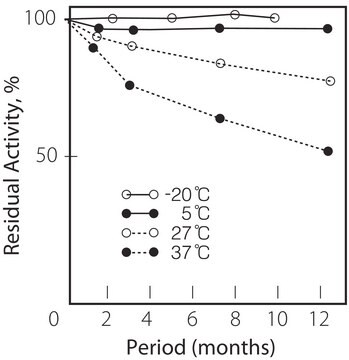C8868
Cholesterol Oxidase from Brevibacterium
lyophilized powder, ≥50 units/mg protein, recombinant, expressed in E. coli
Synonyme(s) :
Cholesterol: oxygen oxidoreductase
Se connecterpour consulter vos tarifs contractuels et ceux de votre entreprise/organisme
About This Item
Produits recommandés
Produit recombinant
expressed in E. coli
Niveau de qualité
Forme
lyophilized powder
Activité spécifique
≥50 units/mg protein
Poids mol.
64 kDa
Composition
Protein, ≥15% biuret
Température de stockage
−20°C
Application
Cholesterol oxidase has been used in a study to demonstrate that microheterogeneity in hydrophobic-hydrophilic block copolymer systems can be exploited for immobilizing enzymes and to carry out enzymatic reactions. Cholesterol oxidase has also been used in a study that concluded that amphipaths that activate cholesterol might be useful in treating NPC disease.
Cholesterol oxidase is used to determine serum cholesterol. The enzyme also finds application in the microanalysis of steroids in food samples and in distinguishing 3-ketosteroids from 3β-hydroxysteroids. Transgenic plants expressing cholesterol oxidase are being investigated in the fight against the cotton boll weevil. CHOD has also been used as a molecular probe to elucidate cellular membrane structures.
Actions biochimiques/physiologiques
Cholesterol oxidase (CHOD) is a monomeric flavoprotein containing FAD that catalyzes the first step in cholesterol catabolism. This bifunctional enzyme oxidizes cholesterol to cholest-5-en-3-one in an FAD-requiring step, which is then isomerized to cholest-4-en-3-one with the release of H2O2.
Propriétés physiques
Type II cholesterol oxidase containing FAD cofactor covalently linked to the enzyme.
Définition de l'unité
One unit will convert 1.0 μmole of cholesterol to 4-cholesten-3-one per min at pH 7.5 at 25 °C. Note: 4-cholesten-3-one may undergo isomerization.
Forme physique
Supplied as a lyophilzed powder containing sucrose
Mention d'avertissement
Danger
Mentions de danger
Conseils de prudence
Classification des risques
Resp. Sens. 1
Code de la classe de stockage
11 - Combustible Solids
Classe de danger pour l'eau (WGK)
WGK 3
Point d'éclair (°F)
Not applicable
Point d'éclair (°C)
Not applicable
Équipement de protection individuelle
Eyeshields, Gloves, type N95 (US)
Faites votre choix parmi les versions les plus récentes :
Déjà en possession de ce produit ?
Retrouvez la documentation relative aux produits que vous avez récemment achetés dans la Bibliothèque de documents.
Les clients ont également consulté
Block copolymer microdomains: a novel medium for enzymatic reactions
Gupte, A., et al.
Biotechnology Progress, 7, 348-354 (2012)
Meihe Zhang et al.
Biosensors & bioelectronics, 32(1), 288-292 (2011-12-31)
A novel cholesterol biosensor was prepared based on gold nanoparticles-catalyzed luminol electrogenerated chemiluminescence (ECL). Firstly, l-cysteine-reduced graphene oxide composites were modified on the surface of a glassy carbon electrode. Then, gold nanoparticles (AuNPs) were self-assembled on it. Subsequently, cholesterol oxidase
Laura Caldinelli et al.
The Journal of biological chemistry, 280(24), 22572-22581 (2005-04-09)
Cholesterol oxidase from Brevibacterium sterolicum is a monomeric flavoenzyme catalyzing the oxidation and isomerization of cholesterol to cholest-4-en-3-one. This protein is a class II cholesterol oxidases, with the FAD cofactor covalently linked to the enzyme through the His(69) residue. In
Effect of cholesterol concentration on organization of viral and vesicle membranes. Probed by accessibility to cholesterol oxidase.
R Pal et al.
The Journal of biological chemistry, 255(12), 5802-5806 (1980-06-25)
D R Corbin et al.
Plant physiology, 126(3), 1116-1128 (2001-07-18)
Cholesterol oxidase represents a novel type of insecticidal protein with potent activity against the cotton boll weevil (Anthonomus grandis grandis Boheman). We transformed tobacco (Nicotiana tabacum) plants with the cholesterol oxidase choM gene and expressed cytosolic and chloroplast-targeted versions of
Protocoles
Enzymatic Assay of Cholesterol Oxidase
Notre équipe de scientifiques dispose d'une expérience dans tous les secteurs de la recherche, notamment en sciences de la vie, science des matériaux, synthèse chimique, chromatographie, analyse et dans de nombreux autres domaines..
Contacter notre Service technique